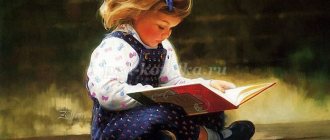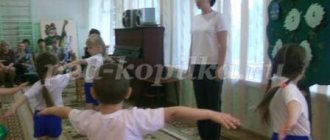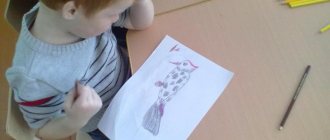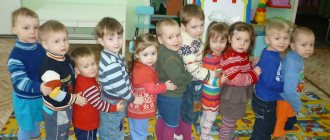Table: card index of topics on labor activity in the senior group of preschool educational institutions
| Author | Savina P.I. | |||
| Type of labor | Subject | Tasks | Examples of work | Note |
| Household labor | "Cleaning up closets and shelves" |
| Try to encourage your children to clear out bookshelves or organize toy cabinets. | Tell the kids a story about slobs and explain that they shouldn’t do that. |
| "Neatly made beds" |
| After quiet time, talk to your children about the importance of keeping their bed tidy. Explain to them in a playful or fairy-tale way about the germs that can appear in the bed if it is not made. | You can cut out figures of microbes from cardboard and place them on the bed of a child who has not made it. | |
| Labor in nature | "Water the plants" |
| Invite the children to take care of the indoor flowers that are in the group. If there are no such flowers, then you can take the children outside and talk about watering plants using the example of street bushes, grass or flower beds. | You can imagine the watering can as a “cloud”. Thanks to this, you will not only show children the principle of working with plants, but also explain what rain is. |
| “Wet wiping of leaves of large-leaved plants” |
| Teach children about the dust that flies in the air and settles on plants. Explain to them how to carefully wipe the leaves. | Try using not only rags, but also damp sponges. They absorb liquid much better and stay wet. They are then easy to dry. | |
| Teamwork | “General work on the corner” | Learn to create collective crafts and figurines to decorate their “children’s corner.” | Use several types of creative materials: paints, pencils, plasticine, cardboard, etc. The main task of the teacher, in addition to instructing and explaining to children how to work, is to control all actions with dangerous tools. | Encourage children to paint with their fingers. You can help color their hands and put them on paper. |
| "Joint and general games" |
| Try playing the group game “Tea-Tea to the Rescue.” The player who will be the “driver” is selected. He runs after other guys and catches them. The child he touches becomes “bewitched.” Another player can touch the “bewitched” and free him. The game ends when all players become "bewitched". | Playing games with sports equipment such as balls or jump ropes is useful not only in terms of developing social skills, but also improves physical abilities. | |
| Self-service | “Independent search for answers to the question posed” |
| Ask your child a question like: “What was the name of the chicken that laid the egg?” Ask your child to find the answer in the story itself. This will prepare him well for future assignments at school. | Question options: “Where is Koshchei’s life hidden?”, “How many knights come out of the sea in Pushkin’s fairy tale?”, “Who is the mermaid?” |
| "Self-care" |
| Provide your child with a clothes brush and talk about how to properly clean clothes. Explain why this should be done (“to look neat”). | Try talking about how to keep your clothes in order so that you have to clean them as little as possible. | |
| Duty | "Duty in the dining room" |
| Select a few children and bring them to the dining room. Then tell them how to set the table and arrange the plates. After this, you can begin practical work and allow the children to do everything on their own. | Try to come up with some little incentives for those guys who were on duty especially well. |
| "Street duty" |
| Give a few kids brooms and offer to sweep the leaves off the paths if it's autumn. In winter, you can ask for help removing small piles of snow using shovels. And in the spring you can show the children how to water the flowers in the flower beds. | Always make sure that your child is assigned only work that he is definitely able to do. | |
| Handmade and artistic work | "Creating Crafts" |
| Try to gather a small group of children and make a plasticine craft with them. For example, the “Hedgehog” craft:
| This type of work allows the teacher to get to know the children better. |
| "Artwork" |
| Give children coloring books and provide pencils. | Try showing your children a few drawings that you can draw yourself. | |
“Organization of a subject-development environment in labor education groups” methodological development
GBOU School 1583 named after. K.A. Kerimova
Preschool department No. 4
Consultation for teachers on the topic:
“Organization of a subject-development environment in labor education groups”
Prepared by:
Educator
Petrova Irina Alexandrovna
Moscow
2019
“Creation of a subject-developing environment for work on labor education issues”
Labor is of decisive importance in the life of every person and in the life of society. His fate largely depends on how a person approaches work, how he knows how to work. Folk art speaks about this vividly and figuratively: proverbs, sayings, fairy tales. Much attention is paid to labor education in folk pedagogy. Many philosophical, psychological and pedagogical works have been written about the importance of labor education.
In the history of upbringing and education of society, unique systems have been created, which are based on labor education. Emphasizing the role of labor education, K.D. Ushinsky wrote: “The opportunity to work and love for it is the best inheritance that both the poor and the rich can leave to their children.”
In the article “The Beginning of All,” national teacher Galina Danilovna writes: “In childhood, the education of feelings is especially important. A little person must be taught to love, feel sorry for, have compassion for people, honor the memory of the dead, and be grateful to people for their work.”
Labor education is a necessary and essential condition for the successful preparation of children for school. Children raised to work from an early age are distinguished in school by their independence, organization, activity, and ability to serve themselves.
Labor education enters a child’s life from a very early age and is carried out consistently and systematically. The task becomes the gradual development in children (taking into account age capabilities and gender characteristics) of interest in the work of adults, cultivating a desire to work, basic labor skills, and hard work.
In accordance with the program, labor education, including its main types: self-service, household work and work in nature, is systematically carried out from the first junior group.
An important place in creating working conditions for children is that all equipment matches the strength and growth of children, is comfortable and has an attractive appearance. Working with heavy, dull or poorly adjusted shovels, rakes, and picks tires children and affects the quality of work.
In the younger group, toy watering cans and buckets can be used to water plants. So that educators can show children the correct techniques of work, you need to have gardening tools for adults.
To store equipment, it is recommended to make a shed or shed and arrange everything there so that children of older preschool age can quickly find and take what they need, and put it back in place after work. For canteen duties and for collective work, it is necessary to have in the group aprons, rags, brushes, brooms, dustpans, basins in the required quantity and store everything in a specially designated place accessible to children. Proper storage and arrangement of equipment is of great importance for instilling in children neatness and respect for things.
To foster hard work and develop work skills, it is necessary to have well-equipped manual labor corners in senior and preparatory groups and arrange them conveniently for children. Working in the corners of manual labor always pleases the children with their results.
In each group, the types and content of children’s labor activity and the tasks that must be solved in the process of child labor are determined.
When organizing work activities, educators must ensure the comprehensive development of children and help them gain confidence in their abilities. Educators should try to organize children’s work in such a way that it activates their physical strength and mental activity, so that it brings joy and allows them to feel significant and competent.
It is necessary to strictly observe the norms of the load performed by children, avoiding their overload and fatigue.
One of the important methods is game situations, game techniques, encouragement, the use of poetic texts, songs, nursery rhymes.
Educators in working with children on labor education and independent activities should use a variety of materials: natural, waste; material for the development of fine motor skills; various designers; educational, didactic games. Educators must not forget that parents must also be involved in matters of labor education.
Educators should exchange recommendations and advice with parents on creating conditions for organizing the work and independent activities of children at home and in kindergarten. Involve parents in active participation in the pedagogical process of kindergarten.
The organization of the process of creating conditions for the labor education of preschool children is regulated by regulatory documents.
And so, for the successful solution of the tasks provided for by the program for the labor education of preschoolers, the creation of the necessary conditions is of paramount importance.
The social and personal development of children of senior preschool age involves the formation of qualities thanks to which the child can successfully establish relationships with peers and adults, and is able to subordinate his behavior to the norms and rules accepted in society.
In the preschool group you can meet children with communication disorders. Shyness, anxiety, lack of self-confidence, aggressiveness or hyperactivity are a problem and a violation in the social and personal development and upbringing of a child. The reasons for these violations can be very different, but they all interfere not only with those around them, but also with the children themselves. These data indicate the importance and necessity of carrying out work on the social and personal development of children in preschool educational institutions.
In the Federal State Educational Standard for Preschool Education, the educational area “Social and communicative development” is aimed at the social and personal development of preschool children and is represented by the following tasks:
1. Formation of independence, purposefulness and self-regulation of one’s own actions;
2. Formation of positive attitudes towards various types of work.
It is possible to realize these tasks precisely during the work activity of preschoolers.
Let me remind you that the content of work activity in a preschool institution is: 1. Self-service. The ability to dress and undress independently in a certain sequence, correctly and neatly put clothes in a closet, put shoes back in place, dry wet things in a timely manner, care for shoes (wash, wipe, clean).
Learn to notice and independently eliminate problems in your appearance, tactfully tell a friend about a problem in his suit or shoes, and help eliminate it. Self-service skills help develop qualities such as responsiveness and mutual assistance.
2. By involving children in household work, we develop the ability to constantly and timely maintain order in the group and on the site: wipe down toys and aids, building materials, repair books and toys together with the teacher.
The ability of children to independently restore order in the kindergarten area: sweep and clear paths of debris, snow in winter, water sand in the sandbox. Ability to make your own bed after sleep.
Independently and conscientiously perform the duties of the dining room attendants: fully setting the table, distributing second and third (berries, fruits) courses, clearing away dishes after meals, sweeping the floor.
The ability to independently lay out classroom materials prepared by the teacher, put them away, wash brushes, paint sockets, and wipe tables.
Children of older preschool age should be able to organize their workplace and put it in order after classes are over. 3. The organization of labor in nature fosters a love for plants and animals. Teaches how to independently and responsibly perform the duties of a duty officer in a corner of nature. In the fall, it is necessary to involve children in collecting seeds, digging up bulbs, flower tubers, digging up beds, and replanting flowering plants from the ground into a corner of nature.
In winter, shovel snow to the trunks of trees and bushes, grow green food for birds and animals (inhabitants of a corner of nature), plant root crops, grow flowers with the help of a teacher, for the holidays.
In the spring, involve children in digging up soil in the garden and flower garden, sowing seeds (vegetables, flowers), and planting seedlings.
In the summer, involve children in loosening the soil, weeding and hilling, and watering beds and flower beds. 4. Introduction to manual labor develops in children a creative attitude towards the environment. Teaches students to use in independent activities the skills of working with natural materials, paper, cardboard, acquired in the classroom.
It develops in children the ability to independently make attributes for role-playing games, Christmas tree decorations, souvenirs for parents, kindergarten staff, and children.
It is necessary to involve children in the production of manuals for classes and independent activities, in the repair of books, and printed board games.
Learn to use material economically and rationally.
By organizing the child’s work activity in the form of: 1. Assignments (used in all age groups), the teacher teaches the preschooler work skills and accustoms them to sequential completion of tasks. He develops moral and volitional qualities (perseverance, responsibility, self-esteem, self-control);
2. Being on duty in a group contributes to the development of friendly partnerships between children, their awareness of responsibility for the assigned work, for the high-quality and timely completion of all work; 3. When organizing collective work, children develop the ability to distribute responsibilities among themselves, taking into account each other’s interests and providing each other with the necessary assistance.
The developmental component of labor education will consist in complicating the content of work tasks and assignments, in connection with the acquisition of practical experience from preschoolers. Namely, in increasing the volume of work, the degree of generalization in the formulation of tasks, the degree of independence of children, and increasing quality requirements. The work of the teacher in this case is carried out based on the child’s zone of proximal development, which corresponds to the essence of developmental education. When creating an environment conducive to the fulfillment of the task of social and personal development of children through work, it makes sense to organize a “Center for Social and Communicative Development”. It is advisable to place teaching aids in it. For example, it is possible to equip a board game based on the principle of a printed board game with types of work activities, and with the help of another manual “Choice Cube” you can determine the number of participants, the type of work activity, the principle by which children will be united into groups, how the types will be distributed work, etc. Determining the type of duty and assignments will predetermine the nature of the relationships between children in the process of joint work.
Also, in order to enrich the PPRS and in order to form an idea about the work of adults, about the variety of professions, modern technology, machines and mechanisms used by people in work, their role, it is necessary to develop and use thematic albums, presentations for children, and didactic games.
Thanks to the use of these benefits, the basic foundation of children’s labor skills is laid, which is formed precisely in older preschool age. In the future, these developed skills and abilities are only improved.
Equipment for work activity must be well selected, have an attractive appearance, allow the child to complete the task carefully, that is, obtain a result that will encourage him to further activities and arouse the desire to work. The equipment is placed so that it is convenient for children to take it, use it, put it in order and put it in place.
It will be interesting for children to create practical situations “We are the kindest in kindergarten.” Where children learn to take care of children, they develop a sense of self-esteem, a kind attitude towards little ones, and an understanding of their problems.
You can organize the situations “We will delight the kids with gifts made by ourselves”, “We will prepare a concert for the kids”, “We will show a fairy tale”, “We will help make a snow slide”, “We will teach the kids how to dance in circles”.
In order for children to work with pleasure, it is necessary to create an emotionally positive atmosphere. The stability of the habit of working and the formation of a motive - interest in this type of activity - largely depend on the emotional mood of the child and the development of his social feelings. Then any action, even one that requires relatively great stress associated with overcoming difficulties, will be willingly performed by the child. It is also important that the labor process itself and its results are accompanied by positive emotions. For example, in relation to children performing the functions of duty officers, the teacher does a lot of work to instill respect for the duty officers and their work, and for the requirements of the duty officers. A good emotional atmosphere is created by discussing the results of duty. As a result, the work of duty officers is characterized by children from the perspective of socially useful work.
A positive emotional mood is supported by the fact that the teacher draws children’s attention to the “intermediate” results of the work being performed, trying to awaken curiosity and independence. Involving children in work only for the sake of developing labor skills will not allow them to instill industriousness, without which work loses its educational and, subsequently, social significance.
In the process of learning to work, the work process itself needs to be demonstrated to children in stages. The teacher draws the children's attention to the intermediate result obtained, emphasizing its difference from the final result. This achieves a dismembered perception of the labor process. The obtained result is used only for its intended purpose. Then the child establishes a connection between the result, the goal and the labor actions of the working person.
The highest degree of mastery of labor activity is activity on one’s own initiative. Children themselves set a goal, plan the organization and execution of work, achieve a result, evaluate its quality and significance, as well as the behavior of a friend and their own in the work process (attitude towards work and towards peers).
To achieve a high level of mastery of labor activity, children must be taught:
1. The main components of labor. To do this, children need to be introduced to the work of adults. Where the guys watch the production of various objects and their transformation.
2. Children must know the structure of the labor process (goal, choice of material, tools, labor actions, planned result). The purpose and result of work for children to understand are motivated by the practical needs of children or adults;
3. Children know the rules for organizing the labor process (selection of the necessary material, its convenient location, cleaning the workplace after finishing work).
4. Children know how to choose a material with certain properties, purposes of the result of labor;
5. Children know how to pre-prepare tools and equipment, choose a set of tools, taking into account the purpose of the work and the characteristics of a particular material;
The daily life of children in kindergarten, filled with work activity, requires from them labor efforts, and from the teacher - constant attention to how carefully and timely his pupils carry out work tasks, what attitude they show towards things, order, and peers. When taking on any task, the teacher will certainly organize the children to complete it. In this way he creates in the group an atmosphere of constant employment, constant striving for useful work. Thus, in the process of organizing work activities under the guidance of a teacher, older preschoolers master a number of work skills. The organization of children’s work activity not only has educational significance for the formation of the child’s personality, his primary socialization and the development of personal qualities, but also provides certain skills in preparing for school. Children develop curiosity, independence and observation, an understanding of cause-and-effect relationships, and the ability to think independently. In their work life, even the most insecure children become purposeful and active.
REQUIREMENTS FOR THE ORGANIZATION OF A SUBJECT-DEVELOPMENT ENVIRONMENT FOR LABOR EDUCATION IN A PRESIDENTIAL INDUSTRY. Preschool childhood is considered as a unique period of human development, when the basis of personality is laid and intensive physical and mental development occurs. The innovative processes taking place in modern Russian education necessitate the replacement of traditional values of educating a small child with the values of developing his personality. At the same time, in the conditions of humanization and democratization of the modern educational process, its orientation towards the development of the child’s personality, it became possible to freely choose the means, methods and techniques of working with children, taking into account their individual, age and gender characteristics. The “Concept of Preschool Education” emphasizes that work activity corresponds to the main stream of the mental development of a preschool child due to its attractiveness and the opportunity to demonstrate one’s autonomy and independence from an adult, and is considered a natural means of child development. Psychologists also emphasize that work, as one of the universal human values, is an effective means of developing a child’s personal identity. In order for work activity as a means of developing a child and his creative abilities not to fade into the background, teachers must create a subject-based developmental environment that would have a positive impact on the child’s personality and satisfy the need for joint activities and social and personal development. What are the requirements for organizing a subject-specific development environment?
1. Variety and availability of materials for artistic manual labor (waste, natural, artistic, etc.), their compliance with pedagogical and hygienic requirements.
2. A variety of labor equipment (for household work, work in nature and on the site). Compliance with the age characteristics of children.
3. Aestheticization and attractiveness of work equipment, the presence of a uniform for work, an aesthetically designed workplace for work, etc.
4. Hygienic conditions for organizing the work of children (adaptation of work tools to the physical capabilities of children, regulation of lighting, ventilation, safety of work tools)
5. Availability of benefits that stimulate children’s labor activity (models of teaching labor processes, table setting algorithms, technological and operational maps, safety instructions, exhibitions of children’s works, etc.)
6. Availability of conditions for children’s independent work and duty (duty officers’ corners, instructions for duty officers).
7. Availability of centers for various types of labor (manual labor corners, carpentry workshop, doll studio, nature labor corner, etc.), taking into account gender differentiation and the interests of children.
8. Creating conditions for organizing the work of children outside the group (flower garden, vegetable garden, winter garden).
9. The gaming material environment (toys, substitute items, children's household appliances, play corners, etc.) is constantly updated as one becomes familiar with work processes.
10. Involving children in the production of models of the labor process, models of techniques for working with various tools, albums of patterns, drawings, etc.
11. Involving children in the production of manuals for the group, attributes for role-playing games, decoration elements for the holiday; to carry out “tasks” of kindergarten employees (sewing buttons, burning designs on boards, etc.)
Thus, by organizing work activities, the teacher ensures the comprehensive development of children, helps them gain confidence in their abilities, develop vital skills and abilities, and fosters responsibility and independence. It is necessary to organize the work of children in such a way that it activates their physical strength and mental activity, brings joy, and allows them to feel significant and competent.
Diagnostics of the results of labor activity in the senior group of preschool educational institutions
The diagnostic card helps the teacher evaluate the results of working with children and sum up the results for the six months. In addition, with the help of this document, the teacher systematizes information and determines what each child has achieved and what he cannot cope with.
The diagnostic card records all types of work activities of senior group students.
Table: example of a diagnostic card
| Author | Savina P.I. | ||
| Development indicators | Actions and tasks | Positive result (the child copes with the task) | Negative result (child fails to complete the task) |
| Motivation | Have a desire to participate in work activities | ||
| Gain the skill of taking a proactive approach to business | |||
| Views of adults' work | Desire to provide all possible assistance to adults | ||
| Attitude to work | Desire to learn about future professions | ||
| Respect for other people's work | |||
| Careful attitude towards the results of your work | |||
| The working process | Careful handling of materials | ||
| Use the most productive work methods | |||
| Finish what you started | |||
| Teamwork | Friendliness and ability to work in a team | ||
| Develop communication skills | |||
| Mandatory | Competently evaluate the results of work | ||
| Have the habit of taking orders responsibly | |||
| Labor in nature | Appreciate and respect nature and its gifts | ||
| Have basic plant care skills | |||
| Know how to plant seeds | |||
| Self-service | Be able to take care of your appearance | ||
| Correct your hairstyle and hair | |||
| Manual labor | Know how to glue cardboard and paper | ||
| Strengthen skills in working with scissors | |||
| Duty | Possess basic table setting skills | ||
| Develop independence | |||
| Household work | Know how to wash things | ||
| Making the bed after sleep | |||
Labor activity is the most important aspect of preschoolers’ education. Children develop the skills necessary for future life in society. The teacher should try to help and guide the child, and instill a love of work. The main thing is not to do all the work for the pupils and allow them to express themselves so that they can fully develop their abilities and potential.






